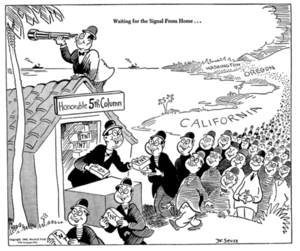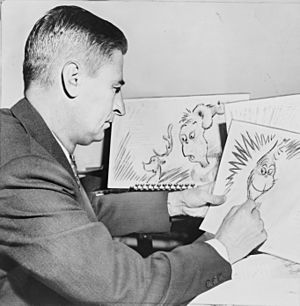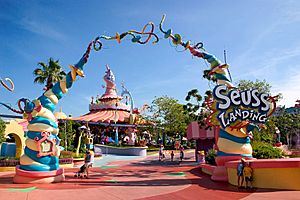Dr. Seuss facts for kids
Quick facts for kids
Dr. Seuss
|
|
|---|---|
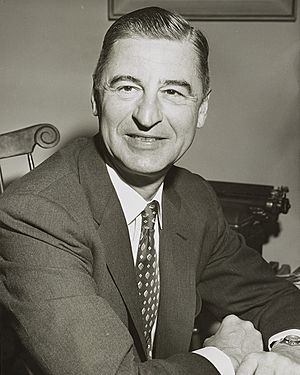
Dr. Seuss in 1957
|
|
| Born | Theodor Seuss Geisel March 2, 1904 Springfield, Massachusetts, U.S. |
| Died | September 24, 1991 (aged 87) San Diego, California, U.S. |
| Pen name |
|
| Occupation |
|
| Education | |
| Genre | Children's literature |
| Years active | 1921–1990 |
| Spouse | |
| Signature | |
 |
|
Theodor Seuss Geisel (born March 2, 1904 – died September 24, 1991) was an American children's author and cartoonist. He is much better known by his pen name, Dr. Seuss. He wrote and illustrated over 60 books, which are some of the most popular children's books ever. By the time he passed away, his books had sold over 600 million copies and were translated into more than 20 languages!
Contents
Early Life and College
Theodor Seuss Geisel was born and grew up in Springfield, Massachusetts. His parents were Henrietta and Theodor Robert Geisel. The famous Mulberry Street from his first children's book, And to Think That I Saw It on Mulberry Street, was near his childhood home.
Geisel went to Dartmouth College and graduated in 1925. There, he worked on the humor magazine Dartmouth Jack-O-Lantern. This is when he started signing his work with the name "Seuss." A professor encouraged his writing, which was a big inspiration for him.
After Dartmouth, he went to Lincoln College, Oxford in England. He planned to study English literature. But at Oxford, he met his future wife, Helen Palmer. She encouraged him to become an artist instead of a teacher.
Starting His Career
Geisel left Oxford without a degree and came back to the United States in 1927. He immediately started sending his drawings and writings to magazines and publishers.
His first cartoon was published in The Saturday Evening Post in July 1927. This success made him move to New York City. Later that year, he got a job as a writer and illustrator for the humor magazine Judge. He felt stable enough to marry Helen Palmer in November 1927. About six months after starting at Judge, his first work signed "Dr. Seuss" was published.
His work became very popular and appeared in magazines like Life and Vanity Fair. The money he earned from his advertising and magazine work allowed him and Helen to travel a lot. They visited 30 countries by 1936! Geisel felt that traveling helped him be more creative.
Writing Children's Books
In 1936, Geisel was on a ship returning from Europe with his wife. The rhythm of the ship's engines gave him an idea for a poem. This poem became his first children's book, And to Think That I Saw It on Mulberry Street. Many publishers rejected the book, but he finally found one through a chance meeting with an old college friend.
Before World War II, Geisel wrote a few more books. These included The 500 Hats of Bartholomew Cubbins (1938) and Horton Hatches the Egg (1940). Horton Hatches the Egg was written in verse, which became his famous style.
During World War II, he paused writing children's books. He drew political cartoons and worked in the United States Army's animation department. He helped create films, including Design for Death, which won an Academy Award in 1947.
After the war, Geisel went back to writing children's books. He created many classics that you might know, such as:
- If I Ran the Zoo (1950)
- Horton Hears a Who! (1955)
- The Cat in the Hat (1957)
- How the Grinch Stole Christmas! (1957)
- Green Eggs and Ham (1960)
- The Lorax (1971)
- Oh, the Places You'll Go! (1990)
He published over 60 books in his career. Many of them have been made into movies, TV shows, and even a Broadway musical!
The Cat in the Hat
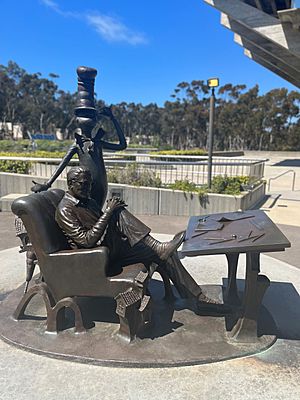
In the 1950s, a report said that children weren't learning to read well because their books were boring. A publisher challenged Geisel to write a book using only a small list of simple words. He wanted a book that children couldn't put down!
Nine months later, Geisel finished The Cat in the Hat. He used 236 of the words he was given. The book had his fun drawing style and rhyming words. But because it used simple words, new readers could enjoy it easily. The Cat in the Hat and other books he wrote for young children became hugely popular around the world.
Even today, his books sell millions of copies every year. For example, in 2009, Green Eggs and Ham sold 540,000 copies! The Cat in the Hat sold 452,000 copies, and One Fish, Two Fish, Red Fish, Blue Fish sold 409,000 copies. These numbers show how much kids still love his stories.
Geisel continued to write many more children's books. Some used his new simple-vocabulary style (called Beginner Books), and others used his older, more detailed style.
Personal Life
Dr. Seuss's first wife, Helen, passed away in 1967. Eight months later, in 1968, Geisel married Audrey Dimond.
Even though he wrote so many books for children, Dr. Seuss never had any children of his own. He once said, "You have 'em; I'll entertain 'em." Audrey added that he was very happy without children. Audrey looked after his works and legacy until she passed away in 2018.
Death
Theodor Seuss Geisel passed away on September 24, 1991, at his home in San Diego. He was 87 years old.
Interesting Facts About Dr. Seuss
- When he was young, Geisel and his sister faced some challenges because their family was of German descent during World War I.
- His birthday, March 2, is now celebrated as National Read Across America Day. This day encourages reading across the United States.
- Geisel often wrote his books using a special rhythm called anapestic tetrameter. This is a poetic style that many famous poets use. It's one reason why his writing was so well-liked.
- He didn't start his stories with a "moral" in mind. He felt that "kids can see a moral coming a mile off." He wanted kids to enjoy the story first.
- Many people mispronounce his last name! He said it rhymed with "voice," not "deuce."
You're wrong as the deuce
And you shouldn't rejoice
If you're calling him Seuss.
He pronounces it Soice (or Zoice)
Awards and Honors
Dr. Seuss received many awards for his amazing work:
- He won the Lewis Carroll Shelf Award twice, for Horton Hatches the Egg (1958) and And to Think That I Saw It on Mulberry Street (1961).
- He received the Regina Medal from the Catholic Library Association in 1982.
- He won two Primetime Emmy Awards for his TV specials: Halloween Is Grinch Night (1978) and The Grinch Grinches the Cat in the Hat (1982).
- In 1980, he received the Laura Ingalls Wilder Medal for his lasting contributions to children's literature.
- He was given a special Pulitzer Prize in 1984 for his work educating and entertaining children and their parents for nearly 50 years.
- He has a star on the Hollywood Walk of Fame.
- Since 2001, Dr. Seuss has been on Forbes magazine's list of the world's highest-paid dead celebrities every year.
Posthumous Honors
Even after his death, Dr. Seuss continues to be honored:
- In 1995, the University Library Building at the University of California, San Diego was renamed Geisel Library. This honored Dr. Seuss and Audrey for their generous support of the library and their dedication to improving reading skills.
- The Dr. Seuss National Memorial Sculpture Garden opened in Springfield, Massachusetts, in 2002. It has sculptures of Dr. Seuss and many of his characters.
- In 2008, Dr. Seuss was inducted into the California Hall of Fame.
- The Theodor Seuss Geisel Award was created in 2004. It recognizes the best American book for beginning readers published each year.
- At his old college, Dartmouth, students are traditionally served green eggs for breakfast at a lodge. In 2012, the Dartmouth Medical School was renamed the Audrey and Theodor Geisel School of Medicine in their honor.
- On March 2, 2009, the search engine Google changed its logo to celebrate Dr. Seuss's 105th birthday.
Adaptations
For most of his life, Dr. Seuss didn't want his characters used outside of his books. But he did allow some animated cartoons to be made. As he got older, he became more open to other projects.
The first cartoon based on his work was Horton Hatches the Egg in 1942. It was made by Warner Bros..
Many of Dr. Seuss's books have been turned into movies and TV shows over the years. Some popular ones include:
- How the Grinch Stole Christmas (2000)
- The Cat in the Hat (2003)
- Horton Hears a Who! (2008)
- The Lorax (2012)
- The Grinch (2018)
There have also been many TV specials, like the classic How the Grinch Stole Christmas! from 1966. And there are TV series, such as The Cat in the Hat Knows a Lot About That! and Green Eggs and Ham.
Dr. Seuss Quotes
Here are some famous quotes from Dr. Seuss:
- "Don't cry because it's over. Smile because it happened."
- "Unless someone like you cares a whole awful lot, nothing is going to get better. It's not."
- "You're in pretty good shape for the shape you are in."
- "You're never too old, too wacky, too wild, to pick up a book and read to a child."
See also
 In Spanish: Dr. Seuss para niños
In Spanish: Dr. Seuss para niños


